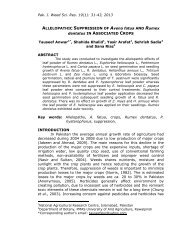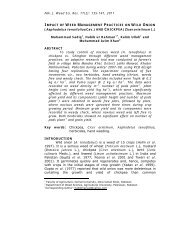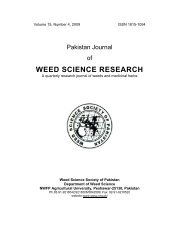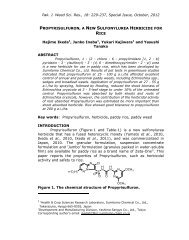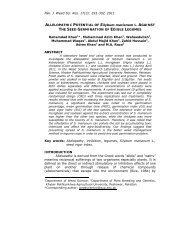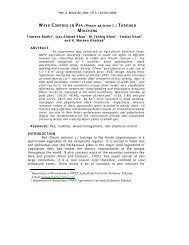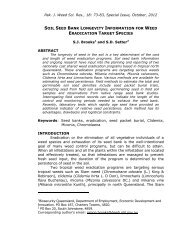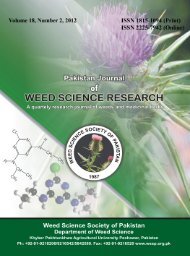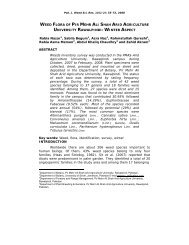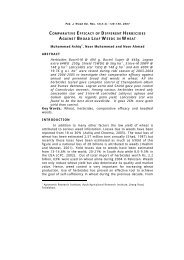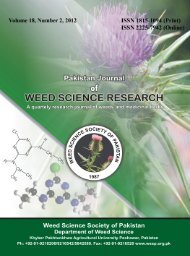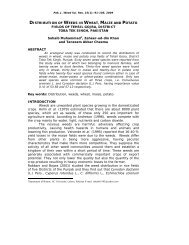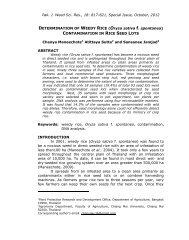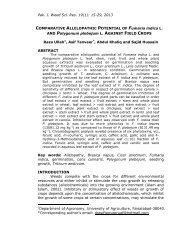Impact of mungbean-maize intercropping on growth ... - Wssp.org.pk
Impact of mungbean-maize intercropping on growth ... - Wssp.org.pk
Impact of mungbean-maize intercropping on growth ... - Wssp.org.pk
Create successful ePaper yourself
Turn your PDF publications into a flip-book with our unique Google optimized e-Paper software.
Pak. J. Weed Sci. Res. 18(2): 191-200, 2012<br />
IMPACT OF MUNGBEAN-MAIZE INTERCROPPING ON GROWTH<br />
AND YIELD OF MUNGBEAN<br />
Muhammad Azim Khan 1 , Khalid Naveed 2 , Kawsar Ali 1 , Bashir<br />
Ahmad and Samin Jan 3<br />
ABSTRACT<br />
The influence <str<strong>on</strong>g>of</str<strong>on</strong>g> different <str<strong>on</strong>g>intercropping</str<strong>on</strong>g> treatments <strong>on</strong> yield and<br />
yield comp<strong>on</strong>ents <str<strong>on</strong>g>of</str<strong>on</strong>g> <str<strong>on</strong>g>mungbean</str<strong>on</strong>g> was investigated at the New<br />
Developmental Farm <str<strong>on</strong>g>of</str<strong>on</strong>g> Khyber Pakhtunkhwa Agricultural University<br />
Peshawar. The experiment was laid out in a randomized complete block<br />
design with three replicati<strong>on</strong>s, and comprised <str<strong>on</strong>g>of</str<strong>on</strong>g> five treatments viz, sole<br />
<str<strong>on</strong>g>mungbean</str<strong>on</strong>g>, <str<strong>on</strong>g>maize</str<strong>on</strong>g> + 1 row <str<strong>on</strong>g>of</str<strong>on</strong>g> <str<strong>on</strong>g>mungbean</str<strong>on</strong>g> simultaneously seeded,<br />
intercrop <str<strong>on</strong>g>maize</str<strong>on</strong>g> + 2 rows <str<strong>on</strong>g>of</str<strong>on</strong>g> <str<strong>on</strong>g>mungbean</str<strong>on</strong>g> simultaneously seeded, intercrop<br />
<str<strong>on</strong>g>maize</str<strong>on</strong>g> + 1 row <str<strong>on</strong>g>of</str<strong>on</strong>g> <str<strong>on</strong>g>mungbean</str<strong>on</strong>g> delay seeded by 3 weeks, intercrop <str<strong>on</strong>g>maize</str<strong>on</strong>g> +<br />
2 rows <str<strong>on</strong>g>of</str<strong>on</strong>g> <str<strong>on</strong>g>mungbean</str<strong>on</strong>g> delay seeded by 3 weeks. The treatments<br />
significantly affected nodules plant -1 , nodule dry weight, pods plant -1 ,<br />
number <str<strong>on</strong>g>of</str<strong>on</strong>g> grains pod -1 , thousand grain weight, grain yield and biological<br />
yield; though the impact was n<strong>on</strong>-significant <strong>on</strong> weeds fresh and dry<br />
biomass parameters. Highest number <str<strong>on</strong>g>of</str<strong>on</strong>g> nodules plant -1 (9.87), nodules<br />
dry weight (2.10 g), number <str<strong>on</strong>g>of</str<strong>on</strong>g> pods plant -1 (17.32), number <str<strong>on</strong>g>of</str<strong>on</strong>g> grains<br />
pod -1 (4.23), thousand grain weight ( 39.33 g), biological yield (1654 kg<br />
ha -1 ) and grain yield (525 kg ha -1 ) <str<strong>on</strong>g>of</str<strong>on</strong>g> <str<strong>on</strong>g>mungbean</str<strong>on</strong>g> was recorded in plots<br />
where sole <str<strong>on</strong>g>mungbean</str<strong>on</strong>g> was cultivated as compared to <str<strong>on</strong>g>intercropping</str<strong>on</strong>g> with<br />
<str<strong>on</strong>g>maize</str<strong>on</strong>g> in all combinati<strong>on</strong>s. In c<strong>on</strong>clusi<strong>on</strong>, the sole cultivati<strong>on</strong> <str<strong>on</strong>g>of</str<strong>on</strong>g><br />
<str<strong>on</strong>g>mungbean</str<strong>on</strong>g> was the most effective <str<strong>on</strong>g>intercropping</str<strong>on</strong>g> system in terms <str<strong>on</strong>g>of</str<strong>on</strong>g> yield<br />
and yield comp<strong>on</strong>ents <str<strong>on</strong>g>of</str<strong>on</strong>g> <str<strong>on</strong>g>mungbean</str<strong>on</strong>g> crop.<br />
Key words: <str<strong>on</strong>g>intercropping</str<strong>on</strong>g>, legume, <str<strong>on</strong>g>maize</str<strong>on</strong>g>, <str<strong>on</strong>g>mungbean</str<strong>on</strong>g>, yield.<br />
INTRODUCTION<br />
Mung Bean (Vigna radiata L.), a member <str<strong>on</strong>g>of</str<strong>on</strong>g> the Fabaceae<br />
family, is a tropical legume. It is a warm seas<strong>on</strong> annual, highly<br />
branched and having trifoliate leaves with plants varying from <strong>on</strong>e to<br />
five feet in length. Mungbean seeds are primarily used for food<br />
purposes. They are a rich source <str<strong>on</strong>g>of</str<strong>on</strong>g> lysine and proteins, and thus can<br />
supplement cereal-based human diet. In Pakistan, the whole or split<br />
seed is usually cooked as dhal or boiled with rice (Rosaiah et al., 1993,<br />
Singh and Singh, 1992). Mungbean stalks, leaves and husk c<strong>on</strong>stitute<br />
a significant proporti<strong>on</strong> <str<strong>on</strong>g>of</str<strong>on</strong>g> livestock feed.<br />
Intercropping is the practice <str<strong>on</strong>g>of</str<strong>on</strong>g> growing two or more crops<br />
together in a single field. The main purpose <str<strong>on</strong>g>of</str<strong>on</strong>g> <str<strong>on</strong>g>intercropping</str<strong>on</strong>g> is to<br />
1<br />
KPK Agricultural University Peshawar, Pakistan. 2 Hazara University, Haripur Campus,<br />
Haripur, Pakistan. 3 Department <str<strong>on</strong>g>of</str<strong>on</strong>g> Botany, Islamia College University Peshawar,<br />
Pakistan. Corresp<strong>on</strong>dance email: azim@aup.edu.<strong>pk</strong>.
192 Muhammad Azim Khan et al., <str<strong>on</strong>g>Impact</str<strong>on</strong>g> <str<strong>on</strong>g>of</str<strong>on</strong>g> <str<strong>on</strong>g>mungbean</str<strong>on</strong>g>-<str<strong>on</strong>g>maize</str<strong>on</strong>g> …<br />
produce a greater yield <strong>on</strong> a given piece <str<strong>on</strong>g>of</str<strong>on</strong>g> land by making use <str<strong>on</strong>g>of</str<strong>on</strong>g><br />
resources that would otherwise not be utilized by a single crop<br />
efficiently. Legume <str<strong>on</strong>g>intercropping</str<strong>on</strong>g> systems play a significant role in the<br />
efficient utilizati<strong>on</strong> <str<strong>on</strong>g>of</str<strong>on</strong>g> resources. Cereal-legume <str<strong>on</strong>g>intercropping</str<strong>on</strong>g> is a more<br />
productive and pr<str<strong>on</strong>g>of</str<strong>on</strong>g>itable cropping system in comparis<strong>on</strong> with solitary<br />
cropping (Evan et al., 2001). Philosophy <str<strong>on</strong>g>of</str<strong>on</strong>g> <str<strong>on</strong>g>intercropping</str<strong>on</strong>g> is<br />
improvement <str<strong>on</strong>g>of</str<strong>on</strong>g> resource utilizati<strong>on</strong> efficiency and increase producti<strong>on</strong><br />
per unit area (Zhang et al., 2007). Kumar et al. (2008) c<strong>on</strong>cluded that<br />
soil surface remained moist in the intercrop during dry spell <str<strong>on</strong>g>of</str<strong>on</strong>g> 6-8<br />
days when compared to sole <str<strong>on</strong>g>maize</str<strong>on</strong>g> cropping. Decline <str<strong>on</strong>g>of</str<strong>on</strong>g> external inputs<br />
and increased demand <str<strong>on</strong>g>of</str<strong>on</strong>g> home grown feed together with a more<br />
efficient nutrient use from leguminous symbiotic dinitrogen (N2)<br />
fixati<strong>on</strong> (SNF) can result in a decrease <str<strong>on</strong>g>of</str<strong>on</strong>g> nitrogen and mineral losses.<br />
The main subject <str<strong>on</strong>g>of</str<strong>on</strong>g> <str<strong>on</strong>g>intercropping</str<strong>on</strong>g> is to augment total<br />
productivity per unit area and time, besides judicious and equitable<br />
utilizati<strong>on</strong> <str<strong>on</strong>g>of</str<strong>on</strong>g> land resources and farming inputs including labors (Marer<br />
et al., 2007). Maize + legume <str<strong>on</strong>g>intercropping</str<strong>on</strong>g> was found more<br />
productive and remunerative compared to sole cropping according to<br />
Li et al., (2003). Intercropping is being c<strong>on</strong>sidered to utilize these<br />
resources in an efficient way and is also the most ec<strong>on</strong>omical way to<br />
increase producti<strong>on</strong> per unit area and per unit time. Intercropping is<br />
becoming popular in Pakistan am<strong>on</strong>g farmers due its multiple benefits<br />
(Nazir et al., 1997). Maize-legume <str<strong>on</strong>g>intercropping</str<strong>on</strong>g> systems are able to<br />
lessen amount <str<strong>on</strong>g>of</str<strong>on</strong>g> nutrients taken from the soil in comparis<strong>on</strong> to a<br />
<str<strong>on</strong>g>maize</str<strong>on</strong>g> m<strong>on</strong>ocrop (Tsubo et al., 2003). Kamanga et al. (2010) reported<br />
that <str<strong>on</strong>g>maize</str<strong>on</strong>g>-legume <str<strong>on</strong>g>intercropping</str<strong>on</strong>g> was a more productive system and a<br />
less risky technology. Higher crop productivity and efficiency in<br />
resource use was observed in <str<strong>on</strong>g>maize</str<strong>on</strong>g>-bean <str<strong>on</strong>g>intercropping</str<strong>on</strong>g> systems than<br />
in the respective sole cropping (Tsubo et al., 2003).<br />
Am<strong>on</strong>g legume-cereal <str<strong>on</strong>g>intercropping</str<strong>on</strong>g> system, the combinati<strong>on</strong> <str<strong>on</strong>g>of</str<strong>on</strong>g><br />
<str<strong>on</strong>g>maize</str<strong>on</strong>g> + pige<strong>on</strong>pea was c<strong>on</strong>sidered to be highly suitable with a<br />
minimum competiti<strong>on</strong> for nutrients, while legume + legume<br />
<str<strong>on</strong>g>intercropping</str<strong>on</strong>g> system, pige<strong>on</strong>pea + groundnut system was the most<br />
efficient <strong>on</strong>e in terms <str<strong>on</strong>g>of</str<strong>on</strong>g> resource use-efficiency (Ghosh et al., 2007).<br />
MATERIALS AND METHODS<br />
The experiment was c<strong>on</strong>ducted at the Agricultural Research<br />
Farm, Khyber Pakhtunkhwa Agricultural University (Peshawar) during<br />
Summer 2011. The experiment c<strong>on</strong>sisted in different <str<strong>on</strong>g>intercropping</str<strong>on</strong>g><br />
combinati<strong>on</strong>s <str<strong>on</strong>g>of</str<strong>on</strong>g> <str<strong>on</strong>g>mungbean</str<strong>on</strong>g> with <str<strong>on</strong>g>maize</str<strong>on</strong>g> in <strong>on</strong>e and two rows,<br />
respectively, with simultaneous and delay sowing. Treatments were<br />
<str<strong>on</strong>g>mungbean</str<strong>on</strong>g> m<strong>on</strong>o cropping, <str<strong>on</strong>g>mungbean</str<strong>on</strong>g>-<str<strong>on</strong>g>maize</str<strong>on</strong>g> <strong>on</strong>e and two row<br />
simultaneously sowing and <str<strong>on</strong>g>mungbean</str<strong>on</strong>g>-<str<strong>on</strong>g>maize</str<strong>on</strong>g> <strong>on</strong>e and two rows delay<br />
sowing by three weeks. The experiment was laid out in randomized
Pak. J. Weed Sci. Res. 18(2): 191-200, 2012 193<br />
complete block design with three replicati<strong>on</strong>s. The crop was grown <strong>on</strong><br />
soil previously ploughed twice and then planked to level the field at<br />
proper moisture. A composite soil sample was taken from<br />
experimental field before planting and samples were collected from<br />
each experimental unit after the harvest <str<strong>on</strong>g>of</str<strong>on</strong>g> the crop for determinati<strong>on</strong><br />
<str<strong>on</strong>g>of</str<strong>on</strong>g> soil fertility. Full dose <str<strong>on</strong>g>of</str<strong>on</strong>g> P and half N was applied at time <str<strong>on</strong>g>of</str<strong>on</strong>g> planting<br />
whereas the remaining half <str<strong>on</strong>g>of</str<strong>on</strong>g> N was applied with first irrigati<strong>on</strong>.<br />
Intercropped treatments did not receive extra fertilizer dose due to the<br />
fact that leguminous crops fix nitrogen to compensate its requirement.<br />
Plot size <str<strong>on</strong>g>of</str<strong>on</strong>g> 4 x 5 m was used. Mungbean seeds were planted by hand<br />
hoe simultaneously or with inter cultivati<strong>on</strong> in <str<strong>on</strong>g>maize</str<strong>on</strong>g> rows as per<br />
treatment descripti<strong>on</strong>. Treflan EC was applied as pre-emergence<br />
herbicide for weeds c<strong>on</strong>trol in <str<strong>on</strong>g>mungbean</str<strong>on</strong>g>. Data were recorded <strong>on</strong><br />
number <str<strong>on</strong>g>of</str<strong>on</strong>g> nodules plant -1 at pod filling stage, dry biomass <str<strong>on</strong>g>of</str<strong>on</strong>g> nodules<br />
plant -1 at pod filling stage, number <str<strong>on</strong>g>of</str<strong>on</strong>g> pods plant -1 , number <str<strong>on</strong>g>of</str<strong>on</strong>g> seeds<br />
pod -1 , 1000 seed weight, biological and grain yield.<br />
Three plants were uprooted with a ball <str<strong>on</strong>g>of</str<strong>on</strong>g> soil for recording<br />
number <str<strong>on</strong>g>of</str<strong>on</strong>g> nodules per plant at pod filling stage. With root porti<strong>on</strong><br />
intact, the ball <str<strong>on</strong>g>of</str<strong>on</strong>g> soil was washed gently with clean water followed by<br />
washing with camel hair-brush to dislodge any soil particles adhering<br />
to it. Nodules were removed from roots for counting their number and<br />
recording dry mass. Numbers <str<strong>on</strong>g>of</str<strong>on</strong>g> pods were counted for sampled plants<br />
and then were averaged for calculating number <str<strong>on</strong>g>of</str<strong>on</strong>g> pods plant -1 .<br />
Similarly weight <str<strong>on</strong>g>of</str<strong>on</strong>g> 1000 seed was recorded for each plot <strong>on</strong> average<br />
basis. To record biological yield, two central rows were harvested in<br />
each treatment, bundled, sun dried and were weighed. The data was<br />
then c<strong>on</strong>verted to kg ha -1 . Grain yield was recorded after threshing<br />
pods <str<strong>on</strong>g>of</str<strong>on</strong>g> each treatment separately and then was c<strong>on</strong>verted to kg ha -1 .<br />
Statistical Analysis<br />
The data were statistically analyzed using the procedure<br />
appropriate for randomized complete block (RCB) design. Means were<br />
compared using least significant difference (LSD) test at 5% level <str<strong>on</strong>g>of</str<strong>on</strong>g><br />
probability when F values are significant (Steel and Torrie, 1983).<br />
RESULTS AND DISCUSSION<br />
Fresh and dry weeds biomass (g m -2 )<br />
Weeds fresh biomass as affected by various <str<strong>on</strong>g>intercropping</str<strong>on</strong>g><br />
intensities and weeds c<strong>on</strong>trol treatment is given in Table-1. Statistical<br />
analysis <str<strong>on</strong>g>of</str<strong>on</strong>g> the data revealed that n<strong>on</strong>e <str<strong>on</strong>g>of</str<strong>on</strong>g> the treatments caused any<br />
significant change in weeds fresh biomass. However, higher fresh<br />
weeds biomass (2760 g) was observed in plots where <str<strong>on</strong>g>maize</str<strong>on</strong>g><str<strong>on</strong>g>mungbean</str<strong>on</strong>g><br />
<strong>on</strong>e row simultaneously <str<strong>on</strong>g>intercropping</str<strong>on</strong>g> was practiced. While<br />
lower fresh weeds biomass (480 g) was produced by sole <str<strong>on</strong>g>mungbean</str<strong>on</strong>g><br />
cultivated plots. Weeds dry biomass as affected by various treatments
194 Muhammad Azim Khan et al., <str<strong>on</strong>g>Impact</str<strong>on</strong>g> <str<strong>on</strong>g>of</str<strong>on</strong>g> <str<strong>on</strong>g>mungbean</str<strong>on</strong>g>-<str<strong>on</strong>g>maize</str<strong>on</strong>g> …<br />
under study showed that the effect <str<strong>on</strong>g>of</str<strong>on</strong>g> all treatment also remained not<br />
significant. Though, lower weeds fresh biomass (132 g) was recorded<br />
in plots where sole <str<strong>on</strong>g>mungbean</str<strong>on</strong>g> was sowed whereas higher weeds fresh<br />
biomass (570 g) was produced by plots where <str<strong>on</strong>g>maize</str<strong>on</strong>g>-<str<strong>on</strong>g>mungbean</str<strong>on</strong>g> two<br />
rows delay sowing was practiced.<br />
Number <str<strong>on</strong>g>of</str<strong>on</strong>g> nodules plant -1<br />
Effective nodulati<strong>on</strong> determines the nitrogen fixati<strong>on</strong> ability <str<strong>on</strong>g>of</str<strong>on</strong>g><br />
legume. Nitrogen fixati<strong>on</strong> by legume is gaining attenti<strong>on</strong> as it<br />
c<strong>on</strong>tributes substantial amount <str<strong>on</strong>g>of</str<strong>on</strong>g> nitrogen in agricultural ecosystems.<br />
Nodule formati<strong>on</strong> is characteristic <str<strong>on</strong>g>of</str<strong>on</strong>g> legume. Maize <str<strong>on</strong>g>mungbean</str<strong>on</strong>g><br />
<str<strong>on</strong>g>intercropping</str<strong>on</strong>g> caused difference in number <str<strong>on</strong>g>of</str<strong>on</strong>g> nodule plant -1 <str<strong>on</strong>g>of</str<strong>on</strong>g><br />
<str<strong>on</strong>g>mungbean</str<strong>on</strong>g>. Higher nodule density (9.87) was recorded in plots where<br />
<str<strong>on</strong>g>mungbean</str<strong>on</strong>g> was sown al<strong>on</strong>e while lower nodules plant -1 (4.98) were<br />
recorded in plots where <str<strong>on</strong>g>maize</str<strong>on</strong>g> was intercropped with <strong>on</strong>e row <str<strong>on</strong>g>of</str<strong>on</strong>g><br />
<str<strong>on</strong>g>mungbean</str<strong>on</strong>g> delay seeded by three weeks which was at par with<br />
<str<strong>on</strong>g>mungbean</str<strong>on</strong>g> intercropped with two rows <str<strong>on</strong>g>of</str<strong>on</strong>g> <str<strong>on</strong>g>maize</str<strong>on</strong>g> seeded delay by three<br />
weeks. Zero competiti<strong>on</strong> and early root establishment in sole<br />
<str<strong>on</strong>g>mungbean</str<strong>on</strong>g> plots might be the possible reas<strong>on</strong> for improved number <str<strong>on</strong>g>of</str<strong>on</strong>g><br />
nodules plant -1 while increase <str<strong>on</strong>g>of</str<strong>on</strong>g> intercropped with <str<strong>on</strong>g>maize</str<strong>on</strong>g> c<strong>on</strong>diti<strong>on</strong>s<br />
were not suitable for nodule establishment as <str<strong>on</strong>g>maize</str<strong>on</strong>g> has deep roots<br />
which are better competitor for available resources as compared to<br />
<str<strong>on</strong>g>mungbean</str<strong>on</strong>g> (Mosses et al., 2010). Our results c<strong>on</strong>firm the findings <str<strong>on</strong>g>of</str<strong>on</strong>g><br />
Saleem (2006) who found higher nodules plant -1 in sole <str<strong>on</strong>g>mungbean</str<strong>on</strong>g><br />
while <str<strong>on</strong>g>mungbean</str<strong>on</strong>g> intercropped in <str<strong>on</strong>g>maize</str<strong>on</strong>g> registered lower nodules plant -1 .<br />
However, Agegnehu and Ghizam (2006) reported that the number <str<strong>on</strong>g>of</str<strong>on</strong>g><br />
nodule plant -1 and nodule dry weight <str<strong>on</strong>g>of</str<strong>on</strong>g> chickpea and <str<strong>on</strong>g>mungbean</str<strong>on</strong>g><br />
increased when intercropped with cereals.<br />
Dry biomass <str<strong>on</strong>g>of</str<strong>on</strong>g> nodules plant -1<br />
Mungbean had a significant role in improving the productivity <str<strong>on</strong>g>of</str<strong>on</strong>g><br />
cereal-based cropping systems mainly because <str<strong>on</strong>g>of</str<strong>on</strong>g> their nitrogen fixing<br />
ability and nodulati<strong>on</strong>. Significant variati<strong>on</strong> was observed when<br />
<str<strong>on</strong>g>mungbean</str<strong>on</strong>g> was intercropped with <str<strong>on</strong>g>maize</str<strong>on</strong>g> in various combinati<strong>on</strong>s<br />
(Table-1). Higher nodule dry biomass per plant (2.10 g) was recorded<br />
in plots where <str<strong>on</strong>g>mungbean</str<strong>on</strong>g> m<strong>on</strong>o cropping was practiced which was at<br />
par with <str<strong>on</strong>g>intercropping</str<strong>on</strong>g> <str<strong>on</strong>g>of</str<strong>on</strong>g> <str<strong>on</strong>g>maize</str<strong>on</strong>g> with <strong>on</strong>e row <str<strong>on</strong>g>of</str<strong>on</strong>g> <str<strong>on</strong>g>mungbean</str<strong>on</strong>g> seeded<br />
simultaneously (2.07) followed by two rows <str<strong>on</strong>g>of</str<strong>on</strong>g> <str<strong>on</strong>g>mungbean</str<strong>on</strong>g> seeded<br />
simultaneously (1.94 g). Mungbean <str<strong>on</strong>g>intercropping</str<strong>on</strong>g> with <str<strong>on</strong>g>maize</str<strong>on</strong>g> delay<br />
sowing by three weeks resulted in lower nodule dry weight plant -1<br />
(1.35 g). Higher nodule dry biomass in sole <str<strong>on</strong>g>mungbean</str<strong>on</strong>g> crop might be<br />
attributed to higher nodule density and formati<strong>on</strong> <str<strong>on</strong>g>of</str<strong>on</strong>g> healthy nodule in<br />
these plots due to no shading effect and no competiti<strong>on</strong> by <str<strong>on</strong>g>maize</str<strong>on</strong>g> crop.<br />
Similar results are reported by Saleem (2006) who c<strong>on</strong>cluded that<br />
higher nodule dry weight plant -1 was recorded in sole <str<strong>on</strong>g>mungbean</str<strong>on</strong>g><br />
cultivated fields while <str<strong>on</strong>g>mungbean</str<strong>on</strong>g> intercropped in <str<strong>on</strong>g>maize</str<strong>on</strong>g> registered
Pak. J. Weed Sci. Res. 18(2): 191-200, 2012 195<br />
lower nodule dry weight plant -1 . Similarly increased dry weight <str<strong>on</strong>g>of</str<strong>on</strong>g><br />
nodule in intercropped treatment might be due to positive effect <str<strong>on</strong>g>of</str<strong>on</strong>g><br />
cereal <strong>on</strong> <str<strong>on</strong>g>mungbean</str<strong>on</strong>g> nodulati<strong>on</strong>. Maximum nodule dry biomass under<br />
<str<strong>on</strong>g>intercropping</str<strong>on</strong>g> system over pure stand <str<strong>on</strong>g>of</str<strong>on</strong>g> legume is an indicati<strong>on</strong> <str<strong>on</strong>g>of</str<strong>on</strong>g><br />
more atmospheric nitrogen fixati<strong>on</strong> in the crop mixture (Agbage et al.,<br />
2002). Higher nodule dry biomass may also be due to the “facilitative<br />
interacti<strong>on</strong>” <str<strong>on</strong>g>of</str<strong>on</strong>g> <str<strong>on</strong>g>intercropping</str<strong>on</strong>g> (Li et al., 2003).<br />
Number <str<strong>on</strong>g>of</str<strong>on</strong>g> pods plant -1<br />
Number <str<strong>on</strong>g>of</str<strong>on</strong>g> pods plant -1 <str<strong>on</strong>g>of</str<strong>on</strong>g> <str<strong>on</strong>g>mungbean</str<strong>on</strong>g> directly influences grain<br />
yield <str<strong>on</strong>g>of</str<strong>on</strong>g> <str<strong>on</strong>g>mungbean</str<strong>on</strong>g>. Different <str<strong>on</strong>g>intercropping</str<strong>on</strong>g> treatments caused<br />
significant variati<strong>on</strong> in pods plant -1 <str<strong>on</strong>g>of</str<strong>on</strong>g> <str<strong>on</strong>g>mungbean</str<strong>on</strong>g>. Pods plant -1 were<br />
higher in case <str<strong>on</strong>g>of</str<strong>on</strong>g> <str<strong>on</strong>g>mungbean</str<strong>on</strong>g> m<strong>on</strong>ocropping (17.32) as compared to<br />
<str<strong>on</strong>g>intercropping</str<strong>on</strong>g> with <str<strong>on</strong>g>maize</str<strong>on</strong>g> while lower pods plant -1 (9.07) were recorded<br />
in plots where <str<strong>on</strong>g>maize</str<strong>on</strong>g> was intercropped with <strong>on</strong>e row <str<strong>on</strong>g>of</str<strong>on</strong>g> <str<strong>on</strong>g>mungbean</str<strong>on</strong>g><br />
seeded delay by three weeks. Possible reas<strong>on</strong> for higher pods plant -1 in<br />
sole <str<strong>on</strong>g>mungbean</str<strong>on</strong>g> plots might be attributed to no inter specific<br />
competiti<strong>on</strong> and better utilizati<strong>on</strong> <str<strong>on</strong>g>of</str<strong>on</strong>g> nitrogen being applied as a starter<br />
dose and fixed by root nodule. Being drought resistant crop <str<strong>on</strong>g>mungbean</str<strong>on</strong>g><br />
crop can not tolerate excess water if it is grown with <str<strong>on</strong>g>maize</str<strong>on</strong>g> as<br />
intercrop where more water is applied. It is also not possible to drain<br />
out all water quickly from <str<strong>on</strong>g>maize</str<strong>on</strong>g> crop which caused reducti<strong>on</strong> in<br />
<str<strong>on</strong>g>mungbean</str<strong>on</strong>g> pods plant -1 (Asim et al., 2006). Similar results are<br />
reported by Islam et al. (2006) who observed that number <str<strong>on</strong>g>of</str<strong>on</strong>g> pods<br />
plant -1 <str<strong>on</strong>g>of</str<strong>on</strong>g> <str<strong>on</strong>g>mungbean</str<strong>on</strong>g> were higher in m<strong>on</strong>oculture as compared to their<br />
corresp<strong>on</strong>ding intercropped.<br />
Number <str<strong>on</strong>g>of</str<strong>on</strong>g> grains pod -1<br />
Grain yield <str<strong>on</strong>g>of</str<strong>on</strong>g> <str<strong>on</strong>g>mungbean</str<strong>on</strong>g> directly depends <strong>on</strong> number <str<strong>on</strong>g>of</str<strong>on</strong>g> grains<br />
pod -1 <str<strong>on</strong>g>of</str<strong>on</strong>g> <str<strong>on</strong>g>mungbean</str<strong>on</strong>g>. Different <str<strong>on</strong>g>intercropping</str<strong>on</strong>g> treatment <str<strong>on</strong>g>of</str<strong>on</strong>g> <str<strong>on</strong>g>mungbean</str<strong>on</strong>g><br />
with <str<strong>on</strong>g>maize</str<strong>on</strong>g> significantly affected number <str<strong>on</strong>g>of</str<strong>on</strong>g> grains pod -1 <str<strong>on</strong>g>of</str<strong>on</strong>g> <str<strong>on</strong>g>mungbean</str<strong>on</strong>g><br />
(Table-2). Number <str<strong>on</strong>g>of</str<strong>on</strong>g> grains pod -1 were higher in case <str<strong>on</strong>g>of</str<strong>on</strong>g> <str<strong>on</strong>g>mungbean</str<strong>on</strong>g><br />
m<strong>on</strong>o cropping (4.23) over all intercrop treatments followed by plots<br />
where <str<strong>on</strong>g>maize</str<strong>on</strong>g> was sown with <str<strong>on</strong>g>mungbean</str<strong>on</strong>g> in tow rows seeded<br />
simultaneously (3.51). Intercropping <str<strong>on</strong>g>of</str<strong>on</strong>g> <str<strong>on</strong>g>maize</str<strong>on</strong>g> with two rows <str<strong>on</strong>g>of</str<strong>on</strong>g><br />
<str<strong>on</strong>g>mungbean</str<strong>on</strong>g> delay sowing by three weeks resulted in fewer grains pod -1<br />
(3.06). Possible reas<strong>on</strong> for higher number <str<strong>on</strong>g>of</str<strong>on</strong>g> grains pod -1 in sole<br />
<str<strong>on</strong>g>mungbean</str<strong>on</strong>g> plots could be attributed to availability <str<strong>on</strong>g>of</str<strong>on</strong>g> more nutrients<br />
and less interspecific competiti<strong>on</strong> between <str<strong>on</strong>g>maize</str<strong>on</strong>g> and <str<strong>on</strong>g>mungbean</str<strong>on</strong>g> crop<br />
for available resources. Plots where <str<strong>on</strong>g>mungbean</str<strong>on</strong>g> were sown al<strong>on</strong>e were<br />
fully exploited to irradiance that improved yield comp<strong>on</strong>ents and light<br />
penetrati<strong>on</strong> to the canopy <str<strong>on</strong>g>of</str<strong>on</strong>g> the legume comp<strong>on</strong>ent (Oljaca et al.,<br />
2000). These results are in c<strong>on</strong>trast to Bhatti et al. (2006) who<br />
observed n<strong>on</strong> significant variati<strong>on</strong> in number <str<strong>on</strong>g>of</str<strong>on</strong>g> grains pod -1 when<br />
<str<strong>on</strong>g>mungbean</str<strong>on</strong>g> was intercropped with sesame.
196 Muhammad Azim Khan et al., <str<strong>on</strong>g>Impact</str<strong>on</strong>g> <str<strong>on</strong>g>of</str<strong>on</strong>g> <str<strong>on</strong>g>mungbean</str<strong>on</strong>g>-<str<strong>on</strong>g>maize</str<strong>on</strong>g> …<br />
Thousand seed weight (g)<br />
Thousand grain weight is an important yield c<strong>on</strong>tributing<br />
parameter which positively affect final yield <str<strong>on</strong>g>of</str<strong>on</strong>g> <str<strong>on</strong>g>mungbean</str<strong>on</strong>g>. Thousand<br />
grain weight was significantly affected by <str<strong>on</strong>g>intercropping</str<strong>on</strong>g> <str<strong>on</strong>g>of</str<strong>on</strong>g> munbbean<br />
with <str<strong>on</strong>g>maize</str<strong>on</strong>g> at various proporti<strong>on</strong>s. Heavier grains (39.33 g) were<br />
recorded in plots where <str<strong>on</strong>g>mungbean</str<strong>on</strong>g> was sown al<strong>on</strong>e while grain weight<br />
was lower in plots where <str<strong>on</strong>g>mungbean</str<strong>on</strong>g> was planted with tow rows <str<strong>on</strong>g>of</str<strong>on</strong>g><br />
<str<strong>on</strong>g>maize</str<strong>on</strong>g> seeded delay by three weeks (28.98 g). Inter cropped<br />
<str<strong>on</strong>g>mungbean</str<strong>on</strong>g> produced lighter grains as compared to sole <str<strong>on</strong>g>mungbean</str<strong>on</strong>g><br />
cultivati<strong>on</strong>. Increments in 1000-grain weight <str<strong>on</strong>g>of</str<strong>on</strong>g> <str<strong>on</strong>g>mungbean</str<strong>on</strong>g> in sole<br />
<str<strong>on</strong>g>mungbean</str<strong>on</strong>g> cultivated plots are attributed to favorable growing<br />
c<strong>on</strong>diti<strong>on</strong>s which improved nutrient and water uptake. It might be due<br />
to increased nitrogen fixati<strong>on</strong> and full utilizati<strong>on</strong> <str<strong>on</strong>g>of</str<strong>on</strong>g> P and N during<br />
growing period by <str<strong>on</strong>g>mungbean</str<strong>on</strong>g> itself while incase <str<strong>on</strong>g>of</str<strong>on</strong>g> <str<strong>on</strong>g>intercropping</str<strong>on</strong>g> these<br />
resources was shared by <str<strong>on</strong>g>maize</str<strong>on</strong>g> crop which is str<strong>on</strong>g competitor as<br />
compared to <str<strong>on</strong>g>mungbean</str<strong>on</strong>g> due its improved plant geometry<br />
(Thavaprakaash et al., 2005). Our results are in agreement with<br />
Saleem (2010) who reported that <str<strong>on</strong>g>mungbean</str<strong>on</strong>g> grain weight and yield<br />
was c<strong>on</strong>vincingly higher when it was sown al<strong>on</strong>e as compared to<br />
intercropped bean.<br />
Biological yield (kg ha -1 )<br />
Biological yield <str<strong>on</strong>g>of</str<strong>on</strong>g> <str<strong>on</strong>g>mungbean</str<strong>on</strong>g> resp<strong>on</strong>ded significantly to various<br />
<str<strong>on</strong>g>intercropping</str<strong>on</strong>g> treatments (Table-2). Sole <str<strong>on</strong>g>mungbean</str<strong>on</strong>g> performed better<br />
than intercropped <str<strong>on</strong>g>mungbean</str<strong>on</strong>g> and higher biological yield was obtained<br />
from plots where <str<strong>on</strong>g>mungbean</str<strong>on</strong>g> was sown al<strong>on</strong>e (kg ha -1 ) followed by<br />
<str<strong>on</strong>g>mungbean</str<strong>on</strong>g> intercropped with <strong>on</strong>e row <str<strong>on</strong>g>of</str<strong>on</strong>g> <str<strong>on</strong>g>maize</str<strong>on</strong>g> seeded simultaneously<br />
while <str<strong>on</strong>g>maize</str<strong>on</strong>g> <str<strong>on</strong>g>mungbean</str<strong>on</strong>g> two rows seeded simultaneously resulted in<br />
lower biological yield. Maize-<str<strong>on</strong>g>mungbean</str<strong>on</strong>g> <str<strong>on</strong>g>intercropping</str<strong>on</strong>g> decreased<br />
<str<strong>on</strong>g>mungbean</str<strong>on</strong>g> biological yield by 21 % as compared to <str<strong>on</strong>g>mungbean</str<strong>on</strong>g> m<strong>on</strong>o<br />
cropping. It might be due to less photosynthetic activities by<br />
<str<strong>on</strong>g>mungbean</str<strong>on</strong>g> crop due to less exposure to sunlight and canopy covered<br />
by <str<strong>on</strong>g>maize</str<strong>on</strong>g> leaves. Intercropping systems between <str<strong>on</strong>g>maize</str<strong>on</strong>g> and <str<strong>on</strong>g>mungbean</str<strong>on</strong>g><br />
may face a complex series <str<strong>on</strong>g>of</str<strong>on</strong>g> inter- and intra-specific competiti<strong>on</strong><br />
which is mostly w<strong>on</strong> by <str<strong>on</strong>g>maize</str<strong>on</strong>g> (Izaurralde et al., 1990). Our results are<br />
supported by Giller and Cadisch (1995) and Evan et al. (2001) who<br />
reported that light use efficiency, water uptake, nutrient absorpti<strong>on</strong><br />
and enzymatic activities were much better in <str<strong>on</strong>g>maize</str<strong>on</strong>g> as compared to<br />
<str<strong>on</strong>g>mungbean</str<strong>on</strong>g> when intercropped with each other. Intercropping<br />
drastically reduced biological yield <str<strong>on</strong>g>of</str<strong>on</strong>g> <str<strong>on</strong>g>mungbean</str<strong>on</strong>g> but <str<strong>on</strong>g>maize</str<strong>on</strong>g> showed<br />
negligible reducti<strong>on</strong>s; the reducti<strong>on</strong>s were evident when the crops<br />
reached at flowering (Singh, 2000).<br />
Grain yield (kg ha -1 )<br />
Data regarding grain yield <str<strong>on</strong>g>of</str<strong>on</strong>g> <str<strong>on</strong>g>mungbean</str<strong>on</strong>g> are presented in Table-<br />
2. Mungbean grain yield varied significantly in different <str<strong>on</strong>g>intercropping</str<strong>on</strong>g>
Pak. J. Weed Sci. Res. 18(2): 191-200, 2012 197<br />
treatments. Higher grain yield (525 kg ha -1 ) was recorded in plots<br />
where <str<strong>on</strong>g>mungbean</str<strong>on</strong>g> was sown al<strong>on</strong>e followed by <str<strong>on</strong>g>maize</str<strong>on</strong>g>-<str<strong>on</strong>g>mungbean</str<strong>on</strong>g> <strong>on</strong>e<br />
row simultaneously seeded plots. Mungbean grain yield was lower<br />
(393 kg ha -1 ) in plots where <str<strong>on</strong>g>maize</str<strong>on</strong>g>-<str<strong>on</strong>g>mungbean</str<strong>on</strong>g> two rows simultaneously<br />
<str<strong>on</strong>g>intercropping</str<strong>on</strong>g> was practiced. Maize <str<strong>on</strong>g>mungbean</str<strong>on</strong>g> Intercropping caused<br />
33% reducti<strong>on</strong>s in <str<strong>on</strong>g>mungbean</str<strong>on</strong>g> yield as compared to sole <str<strong>on</strong>g>mungbean</str<strong>on</strong>g><br />
cultivati<strong>on</strong>. Possible reas<strong>on</strong> for yield loses might be due to interspecific<br />
competiti<strong>on</strong> between <str<strong>on</strong>g>maize</str<strong>on</strong>g> and <str<strong>on</strong>g>mungbean</str<strong>on</strong>g> for below and<br />
above ground <strong>growth</strong> factors i.e. soil moisture, nutrient, space and<br />
solar radiati<strong>on</strong>. Also lower grain yield in intercropped plots may be due<br />
to shading effect <str<strong>on</strong>g>of</str<strong>on</strong>g> <str<strong>on</strong>g>maize</str<strong>on</strong>g> <strong>on</strong> <str<strong>on</strong>g>mungbean</str<strong>on</strong>g> due to variati<strong>on</strong> in plant<br />
architecture. Light capture might be c<strong>on</strong>sidered the primary source <str<strong>on</strong>g>of</str<strong>on</strong>g><br />
competiti<strong>on</strong> as the other major <strong>growth</strong> factors such as water and<br />
nitrogen, were at adequate levels throughout the cropping system.<br />
Similar results are reported by Tsubo and Walker (2002) who observed<br />
28% reducti<strong>on</strong> in <str<strong>on</strong>g>mungbean</str<strong>on</strong>g> yields in the <str<strong>on</strong>g>maize</str<strong>on</strong>g>-bean <str<strong>on</strong>g>intercropping</str<strong>on</strong>g><br />
systems. Mungbean yield and yield attributing parameters adversely<br />
affected in <str<strong>on</strong>g>intercropping</str<strong>on</strong>g> with <str<strong>on</strong>g>maize</str<strong>on</strong>g> and it might be due to poor<br />
competiti<strong>on</strong> <str<strong>on</strong>g>of</str<strong>on</strong>g> <str<strong>on</strong>g>mungbean</str<strong>on</strong>g> for nutrient as compared to <str<strong>on</strong>g>maize</str<strong>on</strong>g><br />
(Sunilkumar et al., 2005). Our findings are str<strong>on</strong>gly supported by<br />
Islam et al. (1995) who c<strong>on</strong>cluded that grain yield <str<strong>on</strong>g>of</str<strong>on</strong>g> <str<strong>on</strong>g>mungbean</str<strong>on</strong>g><br />
declined with increasing <str<strong>on</strong>g>intercropping</str<strong>on</strong>g> intensity with <str<strong>on</strong>g>maize</str<strong>on</strong>g> c<strong>on</strong>firming<br />
that <str<strong>on</strong>g>mungbean</str<strong>on</strong>g> is susceptible to competiti<strong>on</strong> from <str<strong>on</strong>g>maize</str<strong>on</strong>g> in this<br />
<str<strong>on</strong>g>intercropping</str<strong>on</strong>g> system. Light competiti<strong>on</strong> is also suspected <str<strong>on</strong>g>of</str<strong>on</strong>g> being the<br />
primary limiting factor resp<strong>on</strong>sible for reduced <str<strong>on</strong>g>mungbean</str<strong>on</strong>g> yield. Yield<br />
reducti<strong>on</strong> <str<strong>on</strong>g>of</str<strong>on</strong>g> 45% was noted in this cropping system.<br />
Table-1. Fresh and dry weed biomass (g m -2 ), Number <str<strong>on</strong>g>of</str<strong>on</strong>g><br />
nodules plant -1 , nodule dry weight plant -1 (g) and<br />
pods plant -1 <str<strong>on</strong>g>of</str<strong>on</strong>g> <str<strong>on</strong>g>mungbean</str<strong>on</strong>g> as affected by different<br />
<str<strong>on</strong>g>intercropping</str<strong>on</strong>g> treatments.<br />
Treatments Fresh weed<br />
biomass<br />
Dry weed<br />
biomass<br />
Nodules<br />
plant -1<br />
Nodule dry<br />
weight plant -<br />
Pods<br />
plant -1<br />
(g m -2 ) (g m -2 )<br />
1<br />
Mungbean sole 480 15 9.87 a 2.10 a 17.32 a<br />
MMIS 1380 33 8.07 ab 2.07 a 11.77 b<br />
MM2S 1110 28 7.08 bc 1.94 a 9.33 c<br />
MM1D 1320 36 4.87 d 1.28 b 9.07 c<br />
MM2D 2760 63 5.43 cd 1.35 b 9.85 bc<br />
LSD (0.05) NS NS 2.06 0.45 2.393<br />
Means in the same column followed by different letters are significantly<br />
different at p≤0.05.<br />
MM1S and MM2S = <str<strong>on</strong>g>mungbean</str<strong>on</strong>g>-<str<strong>on</strong>g>maize</str<strong>on</strong>g> <strong>on</strong>e and two rows<br />
simultaneously, respectively.
198 Muhammad Azim Khan et al., <str<strong>on</strong>g>Impact</str<strong>on</strong>g> <str<strong>on</strong>g>of</str<strong>on</strong>g> <str<strong>on</strong>g>mungbean</str<strong>on</strong>g>-<str<strong>on</strong>g>maize</str<strong>on</strong>g> …<br />
MM1D and MM2D = Mungbean-<str<strong>on</strong>g>maize</str<strong>on</strong>g> <strong>on</strong>e and two rows delayed<br />
sowing by three weeks<br />
Table-2. Number <str<strong>on</strong>g>of</str<strong>on</strong>g> grains pod -1 , thousand grain weight (g),<br />
biological yield (kg ha -1 ) and grain yield kg ha -1 <str<strong>on</strong>g>of</str<strong>on</strong>g><br />
<str<strong>on</strong>g>mungbean</str<strong>on</strong>g> as affected by different <str<strong>on</strong>g>intercropping</str<strong>on</strong>g><br />
treatments.<br />
Treatments Grains<br />
pod -1<br />
1000 grain<br />
weight<br />
(g)<br />
Biological<br />
yield<br />
(kg ha -1 )<br />
Grain<br />
yield<br />
(kg ha -1 )<br />
Mungbean <strong>on</strong>ly 4.23 a 39.33 a 1654 a 525 a<br />
MMIS 3.24 b 32.25 b 1383 b 468 b<br />
MM2S 3.51 b 34.33 ab 1211 c 393 c<br />
MM1D 3.42 b 34.33 ab 1239 c 419 bc<br />
MM2D 3.06 b 28.98 b 1302 bc 441 bc<br />
LSD (0.05) 0.61 5.52 93.78 53.57<br />
Means in the same column followed by different letters are significantly<br />
different at p≤0.05.<br />
MM1S and MM2S = <str<strong>on</strong>g>mungbean</str<strong>on</strong>g>-<str<strong>on</strong>g>maize</str<strong>on</strong>g> <strong>on</strong>e and two row simultaneously<br />
seeded.<br />
MM1D and MM2D = Mungbean-<str<strong>on</strong>g>maize</str<strong>on</strong>g> <strong>on</strong>e and two rows delayed<br />
sowing by three weeks<br />
ACKNOWLEDGEMENT<br />
This study is a part <str<strong>on</strong>g>of</str<strong>on</strong>g> HEC sp<strong>on</strong>sored project entitled “Soil<br />
fertility and ec<strong>on</strong>omic benefits <str<strong>on</strong>g>of</str<strong>on</strong>g> <str<strong>on</strong>g>maize</str<strong>on</strong>g>-legume <str<strong>on</strong>g>intercropping</str<strong>on</strong>g> and<br />
weed suppressi<strong>on</strong> by inter-row cultivati<strong>on</strong>”. The authors highly<br />
acknowledge the financial support <str<strong>on</strong>g>of</str<strong>on</strong>g> HEC.<br />
REFERENCES CITED<br />
Abbas, M., S. S. Tomer and K. M. Nigma. 1995. Maize (Zea mays L.)-<br />
based <str<strong>on</strong>g>intercropping</str<strong>on</strong>g> systems with pulses under rainfed<br />
c<strong>on</strong>diti<strong>on</strong>. Ind. J. Agri. 65(1): 34-38.<br />
Agbaje, G.O., B.A. Ogunbodede and J.O. Makinde. 2002. Biological and<br />
ec<strong>on</strong>omical efficiency <str<strong>on</strong>g>of</str<strong>on</strong>g> <str<strong>on</strong>g>maize</str<strong>on</strong>g> + soybean intercrop pattern in<br />
rainforest and savanna areas <str<strong>on</strong>g>of</str<strong>on</strong>g> Nigeria. Moor J. Agric. Res. 3:<br />
37- 40.<br />
Agegnehu, G., A. Ghizam and W. Sinebo. 2006. Yield performance and<br />
land-use efficiency <str<strong>on</strong>g>of</str<strong>on</strong>g> barley and faba bean mixed cropping in<br />
Ethiopian highlands. Eur. J. Agr<strong>on</strong>. 25(2): 202-207.<br />
Asim, M., M. Aslam, N. I. Hashmi and N. S. Kisana. 2006. Mung bean<br />
(Vigna radiata) in wheatbased cropping system: An opti<strong>on</strong> for<br />
resource c<strong>on</strong>servati<strong>on</strong> under rainfed ecosystem. Pak. J. Bot. 37<br />
(4): 1197-1204.
Pak. J. Weed Sci. Res. 18(2): 191-200, 2012 199<br />
Bhatti, I. H., R. Ahmad, A. Jabbar, Z. A. Virk and M. Aslam. 2008.<br />
Agro-ec<strong>on</strong>omic performance <str<strong>on</strong>g>of</str<strong>on</strong>g> <str<strong>on</strong>g>mungbean</str<strong>on</strong>g> intercropped in<br />
Sesame under different planting patterns. Pak. J. Agric. Sci.<br />
45(3): 25-28<br />
Evans, J., A. M. Mcneill, M. J. Unkovich, N. A. Fettell and D. P. Heenan.<br />
2001. Net nitrogen balances for cool-seas<strong>on</strong> grain legume<br />
<str<strong>on</strong>g>intercropping</str<strong>on</strong>g> and c<strong>on</strong>tributi<strong>on</strong>s to wheat nitrogen uptake: a<br />
review. Aus. J. Exp. Agric. 41: 347-359.<br />
Ghosh, P. K., K. K. Bandyopadhyay, R. H. Wanjari, M. C. Manna, A. K.<br />
Misra, M. Mohanty and A. S. Rao. 2007. Legume effect for<br />
enhancing productivity and nutrient use-efficiency in major<br />
cropping systems - an Indian perspective: a review. J. Sust.<br />
Agri. 30(1): 59-86.<br />
Giller, K. E. and G. Cadisch. 1995. Future benefits from biological<br />
nitrogen fixati<strong>on</strong>: an ecological approach to agriculture. Plant<br />
Soil. 174: 255-277.<br />
Izaurralde, R. C., N. G. Juma and W. B. McGill. 1990. Crop and<br />
nitrogen yield <str<strong>on</strong>g>of</str<strong>on</strong>g> barley and barley-field pea intercrop in<br />
cryoboreal-subhumid central Alberta. Agr<strong>on</strong>. J. 82: 295-301.<br />
Kamanga, B. C., G. S. R. Waddingt<strong>on</strong>, M. J. Roberts<strong>on</strong> and K. E. Giller.<br />
2010. Risk analysis <str<strong>on</strong>g>of</str<strong>on</strong>g> <str<strong>on</strong>g>maize</str<strong>on</strong>g>-legume crop combinati<strong>on</strong>s with<br />
smallholder farmers varying in resource endowment in central<br />
Malawi. J. Exp. Agric. 46:1-21.<br />
Kumar, R.B.P., S. Ravi and J. S. Balyan. 2008. Effect <str<strong>on</strong>g>of</str<strong>on</strong>g> <str<strong>on</strong>g>maize</str<strong>on</strong>g> (Zea<br />
mays) + black gram <str<strong>on</strong>g>intercropping</str<strong>on</strong>g> and integrated nitrogen<br />
management <strong>on</strong> productivity and ec<strong>on</strong>omics <str<strong>on</strong>g>of</str<strong>on</strong>g> <str<strong>on</strong>g>maize</str<strong>on</strong>g>. Int. J.<br />
Plant Sci. 3(1): 53-57.<br />
Li, L., C. Tang, Z. Rengel and F.S. Zhang. 2003. Chickpea facilitates<br />
phosphorus uptake by intercropped wheat from an <strong>org</strong>anic<br />
phosphorus source. J. Plant Soil. 248: 297-303.<br />
Marer, S. B., B. S. Lingaraju and G. B. Shashidhara. 2007. Productivity<br />
and ec<strong>on</strong>omics <str<strong>on</strong>g>of</str<strong>on</strong>g> <str<strong>on</strong>g>maize</str<strong>on</strong>g> and pige<strong>on</strong>pea <str<strong>on</strong>g>intercropping</str<strong>on</strong>g> under<br />
rainfed c<strong>on</strong>diti<strong>on</strong> in northern transiti<strong>on</strong>al z<strong>on</strong>e <str<strong>on</strong>g>of</str<strong>on</strong>g> karnataka.<br />
Karnataka J. Agric. Sci. 20(1): 1-3.<br />
Moses, G. B. K., M. Ikramullah and M. Shaikh. 2000. The effect <str<strong>on</strong>g>of</str<strong>on</strong>g> N<br />
and P applicati<strong>on</strong> <strong>on</strong> the yield <str<strong>on</strong>g>of</str<strong>on</strong>g> Black gram (Vigna mungo) as<br />
m<strong>on</strong>oculture and intercroping with (Zea mays, L). J. Crop Res.<br />
1: 149-151.<br />
Nazir, M.S., A. Jabbar, I. Ahmad, S. Nawaz and I.H. Bhatti. 2002.<br />
Producti<strong>on</strong> potential andec<strong>on</strong>omics <str<strong>on</strong>g>of</str<strong>on</strong>g> <str<strong>on</strong>g>intercropping</str<strong>on</strong>g> in autumnplanted<br />
sugarcane. Int. J. Agric. Biol. 4(1): 140-142.<br />
Oljaca, S., R. Cvetkovic, D. Kovacevic, G.Vasii and N. Momirovic.<br />
2000. Effect <str<strong>on</strong>g>of</str<strong>on</strong>g> plant arrangement pattern and irrigati<strong>on</strong> <strong>on</strong><br />
efficiency <str<strong>on</strong>g>of</str<strong>on</strong>g> <str<strong>on</strong>g>maize</str<strong>on</strong>g> and bean <str<strong>on</strong>g>intercropping</str<strong>on</strong>g> system. J. Agric. Sci.
200 Muhammad Azim Khan et al., <str<strong>on</strong>g>Impact</str<strong>on</strong>g> <str<strong>on</strong>g>of</str<strong>on</strong>g> <str<strong>on</strong>g>mungbean</str<strong>on</strong>g>-<str<strong>on</strong>g>maize</str<strong>on</strong>g> …<br />
135: 261- 270.<br />
Singh, V. P. 2000. Planting geometry in <str<strong>on</strong>g>maize</str<strong>on</strong>g> and <str<strong>on</strong>g>mungbean</str<strong>on</strong>g><br />
<str<strong>on</strong>g>intercropping</str<strong>on</strong>g> systems under rainfed low hill valley <str<strong>on</strong>g>of</str<strong>on</strong>g> Kuma<strong>on</strong>.<br />
Ind. J. Agr<strong>on</strong>. 45: 274-278.<br />
Sunilkumar, C., R. Rawat and N.P. Melkania. 2005. Forage producti<strong>on</strong><br />
potential and ec<strong>on</strong>omics <str<strong>on</strong>g>of</str<strong>on</strong>g> <str<strong>on</strong>g>maize</str<strong>on</strong>g> (Zea mays) and <str<strong>on</strong>g>mungbean</str<strong>on</strong>g><br />
(Vigna Radiata) <str<strong>on</strong>g>intercropping</str<strong>on</strong>g> under rainfed c<strong>on</strong>diti<strong>on</strong>. Ind. J.<br />
Agr<strong>on</strong>. 50(3): 184-186.<br />
Thavaprakaash, N., K. Velayudham and V.B. Muthukumar. 2005. Effect<br />
<str<strong>on</strong>g>of</str<strong>on</strong>g> Crop Geometry, Intercropping Systems and Integrated<br />
Nutrient Management Practices <strong>on</strong> Productivity <str<strong>on</strong>g>of</str<strong>on</strong>g> Baby Corn<br />
(Zea mays L.) based Intercropping Systems. Res. J. Agric. Biol.<br />
Sci. 1(4): 295-302.<br />
Tsubo, M. and S. Walker. 2002. A model <str<strong>on</strong>g>of</str<strong>on</strong>g> radiati<strong>on</strong> intercepti<strong>on</strong> and<br />
use by <str<strong>on</strong>g>maize</str<strong>on</strong>g> –bean intercrop canopy. J. Agric. Forest Meth.<br />
110: 203-215.<br />
Tsubo, M., S. Walker and E. Mukhala. 2003. Comparis<strong>on</strong>s <str<strong>on</strong>g>of</str<strong>on</strong>g> radiati<strong>on</strong><br />
use efficiency <str<strong>on</strong>g>of</str<strong>on</strong>g> m<strong>on</strong>o-inter-cropping systems with different<br />
row orientati<strong>on</strong>s. Field Crops Res. 71: 17-29.<br />
Zhang, L., W. Werf, S. Zhang, B. Li and J.H.J. Spiertz. 2007. Growth,<br />
yield and quality <str<strong>on</strong>g>of</str<strong>on</strong>g> wheat and cott<strong>on</strong> in relay strip<br />
<str<strong>on</strong>g>intercropping</str<strong>on</strong>g> systems. Field Crops Res. 103: 178-188.



